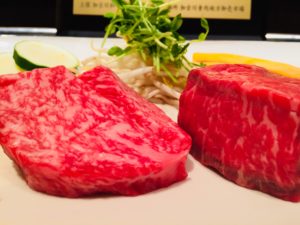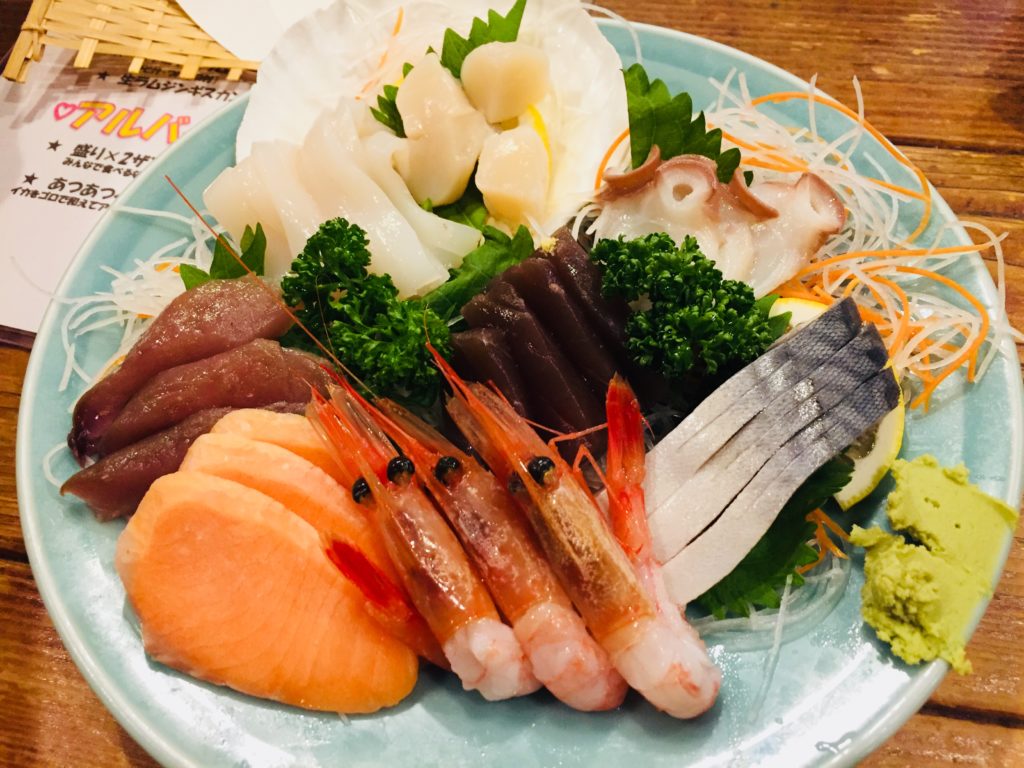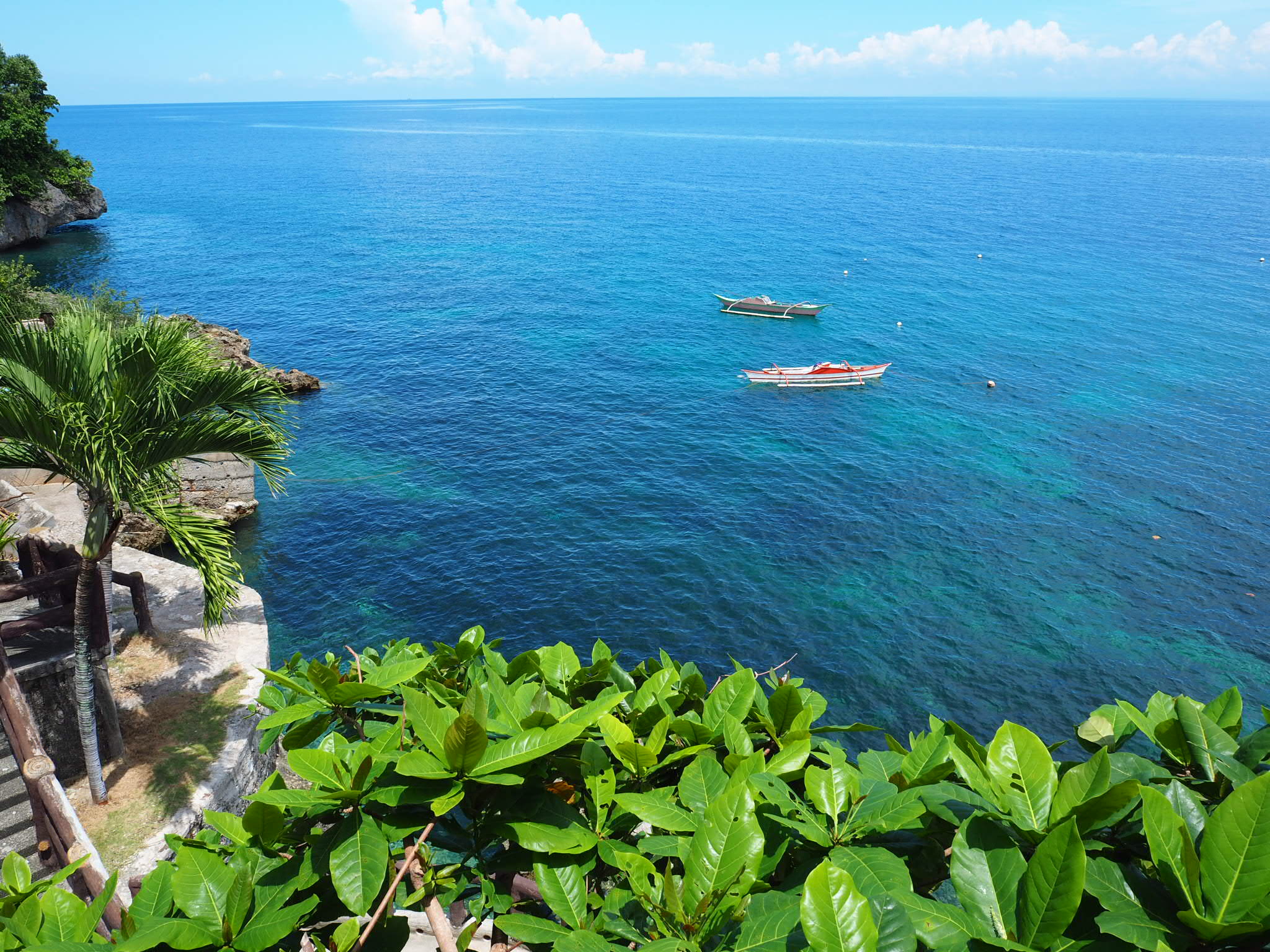What to Eat in Japan
It’s no secret that Japanese food is fantastic and is just one of the highlights of this fascinating country. This is by no means an exhaustive list of the culinary wonders produced in Japan, but these were certainly some of our favourites. Hopefully this little guide will help you plan what to eat in Japan.
Sushi
The most well known cuisine in Japan. Sushi can be affordable or mind numbingly expensive. The choice is very much yours. Most of the sushi we enjoyed was of the conveyor-belt variety. These restaurants are common in most Japanese cities, however out in the countryside they are much harder to find.
Around more popular areas such as Namba or Dotonburi in Osaka or parts of Tokyo prices may be around 128 per plate, however we found a fair few places that were 100 yen per plate. Be aware that the price per plate may not be accurate as this may or may not include tax. It will always say if its included, but it may only be written in Japanese. If you want to be sure, just ask.
Japan has a number of excellent sushi chain restaurants:
Sushiro (スシロー) – This is the biggest 100 yen sushi chain, found all over the country. A huge menu featuring plenty of non sushi dishes.
Kura Sushi (くら寿司) – Another 100 yen sushi chain with an extensive menu including noodles, friends snacks and deserts.
Hama Sushi (はま寿司) – A chain that manages to do 90 yen sushi Monday to Fridays (not on holidays). Like the above two conveyor belt sushi restaurants, the menu here is extensive and delicious.
Do be aware that for all of these chain restaurants the prices are slightly higher if eating at a branch in Tokyo.
Sashimi
Sushi’s bigger brother, this is probably our preference over the traditional nigiri or rolls more commonly associated with sushi. Sashimi is most commonly found at izakaya’s (Japanese style pubs) as well as in sushi restaurants. The best sashimi we had was in Hokkaido, and according to the locals we met, this belief is common amongst many Japanese. Many izakaya’s serve sashimi platters where you get 3, 5 or 7 different types of sashimi, 3 pieces of each. Don’t forget to try scallop, sea urchin and frozen salmon.
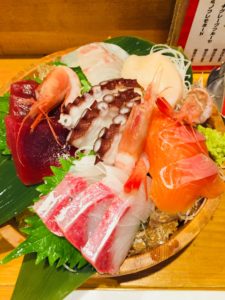
Okonomiyaki
A dish found all over Japan, okonomiyaki is a cooked on a hot steel plate. With a base of cabbage, or noodles if you’re going for Hiroshima style, it’s topped off with onions, tempura bits and your choice of toppings, sauces and fish flakes. This affordable and delicious dish makes a great lunch option.
There are a few places that will let you make it yourself, with clear instructions of course. Quick, easy and delicious.
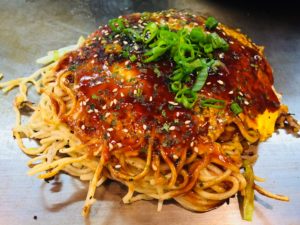
Yakitori
Effectively sticks of meat or vegetables cooked over an open fire. With a huge variety of different cuts, types and sauces, these are usually served in an Izakaya (Japanese Pub). Usually the price will be for 1 or 2 sticks (it will say clearly on the menu). Our personal favourites were fatty belly pork and chicken leg.
In Tokyo take a poke around Shinjuku station for the golden gai alleys. A maze of alleyways filled with restaurants specializing in yakitori. Be prepared for a squeeze as some of the restaurants seat only 5 people. However the food and company will be fantastic.
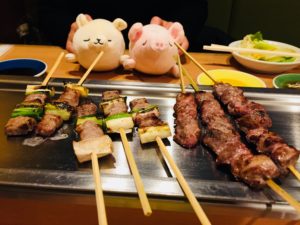
Sukiyaki
This dish consists of vegetables, tofu, and thin slices of beef that you cook at your table in a small amount of water and soy sauce. Not too dissimilar to hot pot. This interesting part comes with what you dip your food into.
Raw Egg
Yep, raw egg. Simply crack the egg into the little bowl you are given, stir it quickly and throughly with your chopsticks and voila, your dip is complete.
This dish is a little harder to find, but Yoshinoya (an affordable Japanese fast food chain) has a cheap and decent Sukiyaki. Their other dishes are pretty good too!
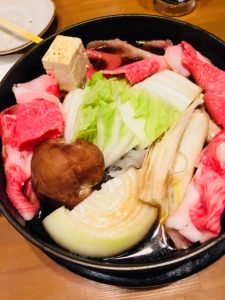
Don Buri
This is like gai fan (盖饭) in Chinese cooking. Meat/vegetables on top of rice. Most popular toppings are various concoctions of beef or pork. Although a pork kimichi bowl is particularly good.
Curry
Katsu-curry usually consists of a fried pork cutlet covered with curry. Delicious, cheap and quick this makes a great lunch option. It is not particularly spicy but it has an intense, rich flavour which is hard to beat.
This type of food has other varieties of course and is pretty easy to find all over Japan.
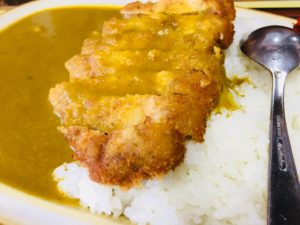
Breakfast
A lot of hotels in Hokkaido include breakfast, this seems to be far less common on the route between Hiroshima and Tokyo. However if you stay in an onsen hotel or Ryokan you will be offered the option of including breakfast. Japanese breakfast generally includes some bread, salad, pickled vegetables, rice, miso soup, an egg and a piece of salted fish (usually salmon in our experience).
At our hotel in the Akan National Park our breakfast included a raw egg. We were both a little confused so the owner came over and showed us what to do:
- Crack the egg into an empty bowl, beat it and add soy sauce.
- Make a little hole in the rice and pour the raw egg mixture in.
- Eat and enjoy.
Takoyaki
The Japanese sounds far more enticing than the English translation of “octopus balls.” Put your doubts to one side and delve in. These little critters are devilishly good and come with a variety of toppings. Originally from Osaka this is understandably the place to get them, but as you’d expect they are delicious wherever you are in Japan. Be careful as they are much hotter on the inside than the outside.
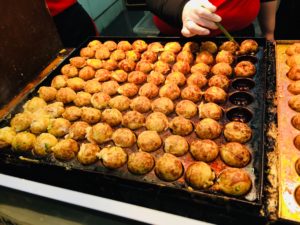
Sweets and Treats
Japan has ungodly amount of sweet chocolatey delights to satisfy even the most ardent sweet tooth. Some of our favourites were various forms taiyaki, a fish shaped (not flavoured) cake that was filled with chocolate, custard or red bean etc etc. These can be found pretty much anywhere and they are deliciously addictive.
Ramen
No article on Japanese cuisine would be complete without ramen. The dish that kickstarted instant noodles is much more delicious that its pre-packaged cousins. This dish is commonly associated with Hokkaido, check out Ramen Yokocho in Sapporo for proof, but it is found all over the country. In a lot of ramen restaurants in big cities like Tokyo and Osaka you purchase meal tickets on a vending-type machine at the entrance before taking a seat while its cooking. Gyoza (pan fried dumplings) make a fantastic side dish.
The meat at the centre of this dish is usually pork usually accompanied by beansprouts, bamboo, seaweed and an egg. Usually the broth has a base flavour of soy sauce, salt or miso (very famous in Hokkaido) although you can find some uber spicy ones here and there if thats your thing!
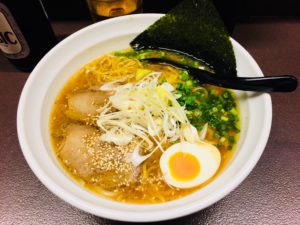
Udon
The “other” Japanese noodle dish. So often playing second fiddle to the main event that is ramen, udon is possibly even better (in my humble opinion). There are a number of flavours and concoctions. Essentially it works like this: Choose you size and base flavour, then choose what fried goodies you want on top. Sprinkle some chives and tempura bits on and you have an extremely filling meal. Incidentally some of our favourite tempera was served in the udon restaurants we visited.
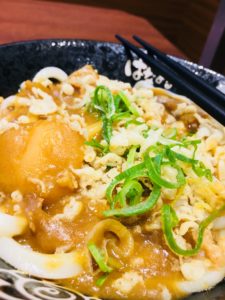
Tempura
Found all over Japan tempura is a great accompaniment with any variety of udon, however it is also served alongside cold soba or buckwheat noodles or just by itself as a side dish. Tempura prawns and squid were our personal favourites, but the vegetables are pretty good too.
As a warning to anyone who gets this dish with cold buckwheat or soba noodles, you are supposed to dip the noodles into the sauce, not pour the sauce onto the noodles as I found out to my embarrassment.
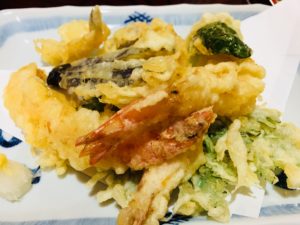
Karaage
Japanese fried chicken. This heavenly piece of goodness can be found almost anywhere, from izakayas to convenience stores. The Chicken is fried with the skin on which is what helps to keep it so moist and tender. As a warning, once youve tried you will be tempted every time you enter a convenience store.
Bento Boxes
Cheap, nutritious and filling bento boxes are a haven for budget travellers. Costing between 500-800 yen bento boxes can be found in any convenience store in Japan where they will also heat it up for you if you wish. Usually they contain a mixture of fried meat, seafood, vegetables and rice, but you can get some that has just one main meat.
Convenience Stores
How is something so simple so wonderful. Convenience stores in Japan have everything. Snacks, sweets, bento boxes, ready meals, dairy produce, bread and even warm fried snacks by the till. Convenience stores have a huge range of delicious goodies for you to try. The main ones are 7-11, family mart and lawsons.
Yakiniku
Yakiniku (Japanese BBQ) is an art form in itself. You take a seat order your raw meat and then cook it on a charcoal grill in front of you. Do be aware that some restaurants will charge a small fee for the cooking apparatus and changing the grill. Usually if this is the case it’s clearly stated at the entrance and in the menu.
For these kinds of restaurants you really need an English menu to make sure you are ordering the cuts of meat you want. Our Chinese served well at most other restaurants where there was no alternative to Japanese but here we needed menus in either English or Chinese to get the most out of the experience.
Generally the best meats to go for are pork or beef. Our favourites were any variety of skirt, loin and short ribs for beef and pork neck, fatty pork and bacon.
Generally the portion sizes are small, its quality over quantity here. As a result this is not something to be eaten quickly. Take your time and enjoy it.
In bigger cities like Tokyo and Osaka there are large numbers of all you can eat BBQ restaurants. Fortunately in these restaurants the portions are extra small so you can sample a huge number of dishes. All of the ones we saw were time limited, for example all you can eat for 1.5 or 2 hours. For an additional fee you upgrade this to all you can drink. Also most restaurants will have 3 different menus to choose, with 3 different prices. The first menu is mainly internal organ and vegetables, the second is everything from the first plus good cuts of beef, pork and chicken plus some addition seafood and vegetables. The third menu is the gourmet option. Both times we ate at this sort of restaurant we opted for the second menu and it was fantastic. Anywhere between 2,500 and 3,500 yen per person.
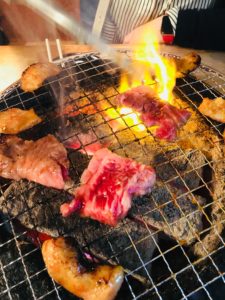
Matsusaka Beef
The fact that only 2500 cows meet the standards each year means it is both hard to find and expensive. We managed to find some at a small street side restaurant in Osaka. It has a different taste and texture to Kobe Beef, but is still a once in a lifetime meal. Like its bigger brother in the beef world this is best enjoyed teppanyaki style.
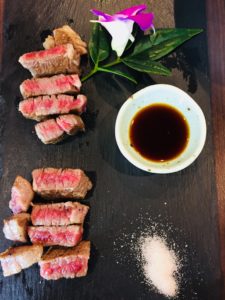
Kobe Beef
This is extremely expensive and there is a reason why. It is absolutely to die for. This is a must to sample for any foodie visiting Japan. Kobe beef is not specifically from Kobe, it is from a particular breed of cow found in Kobe’s prefecture. There are plenty of places around Osaka advertising Kobe beef, but we opted out of trying this delicacy in Osaka and swung by Kobe on our way back from Himeiji to enjoy Kobe beef in Kobe.
We found a tiny restaurant in close to Kobe Sanomiya station. Their food menu contained only one thing; Kobe Beef. We chose 100g of sirloin and 100g of tender red meat. It was cooked to perfection teppanyaki style (on a hot iron plate) with just the perfect amount of salt.
Its not cheap, but this is a once in a life time thing. If you get the chance, do it. However just bear in mind, it will change your views on how meat should taste.
